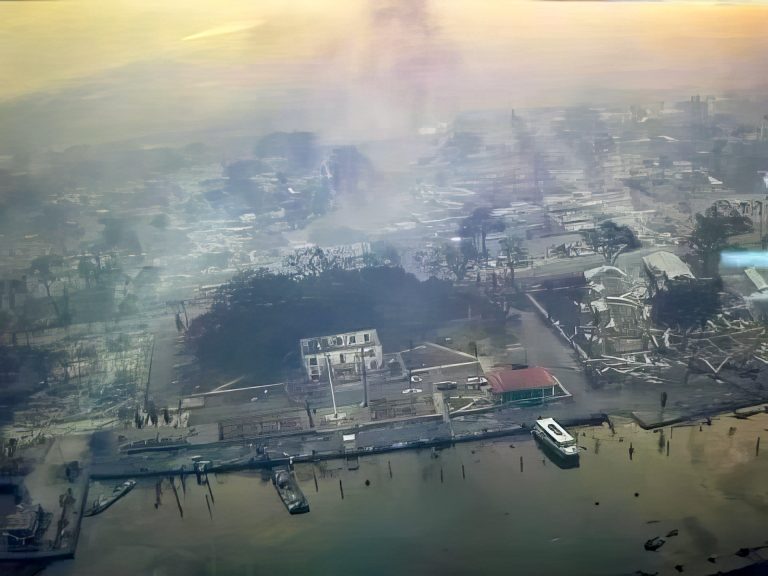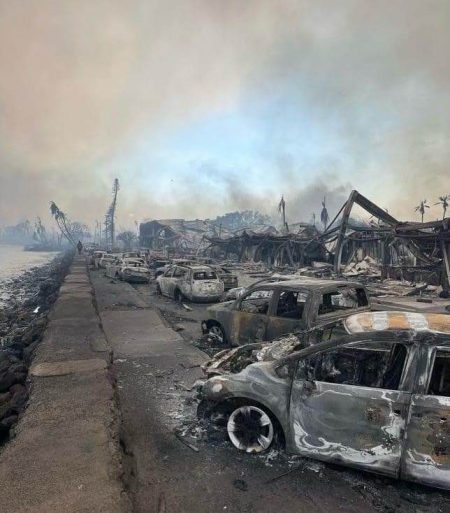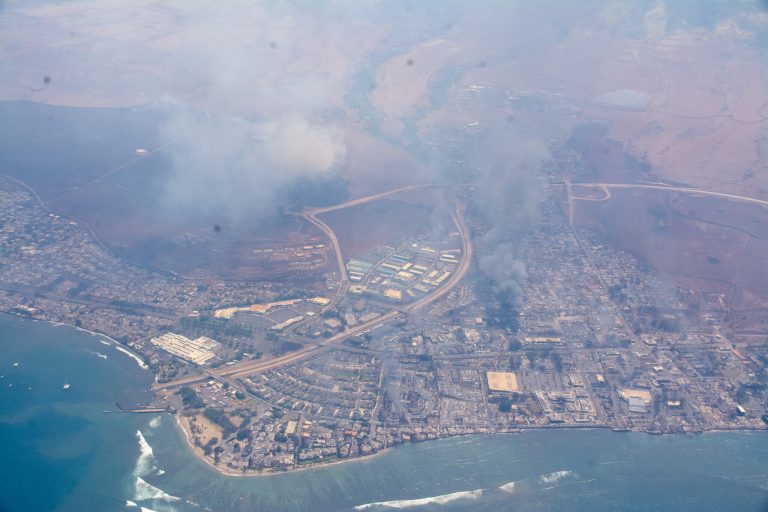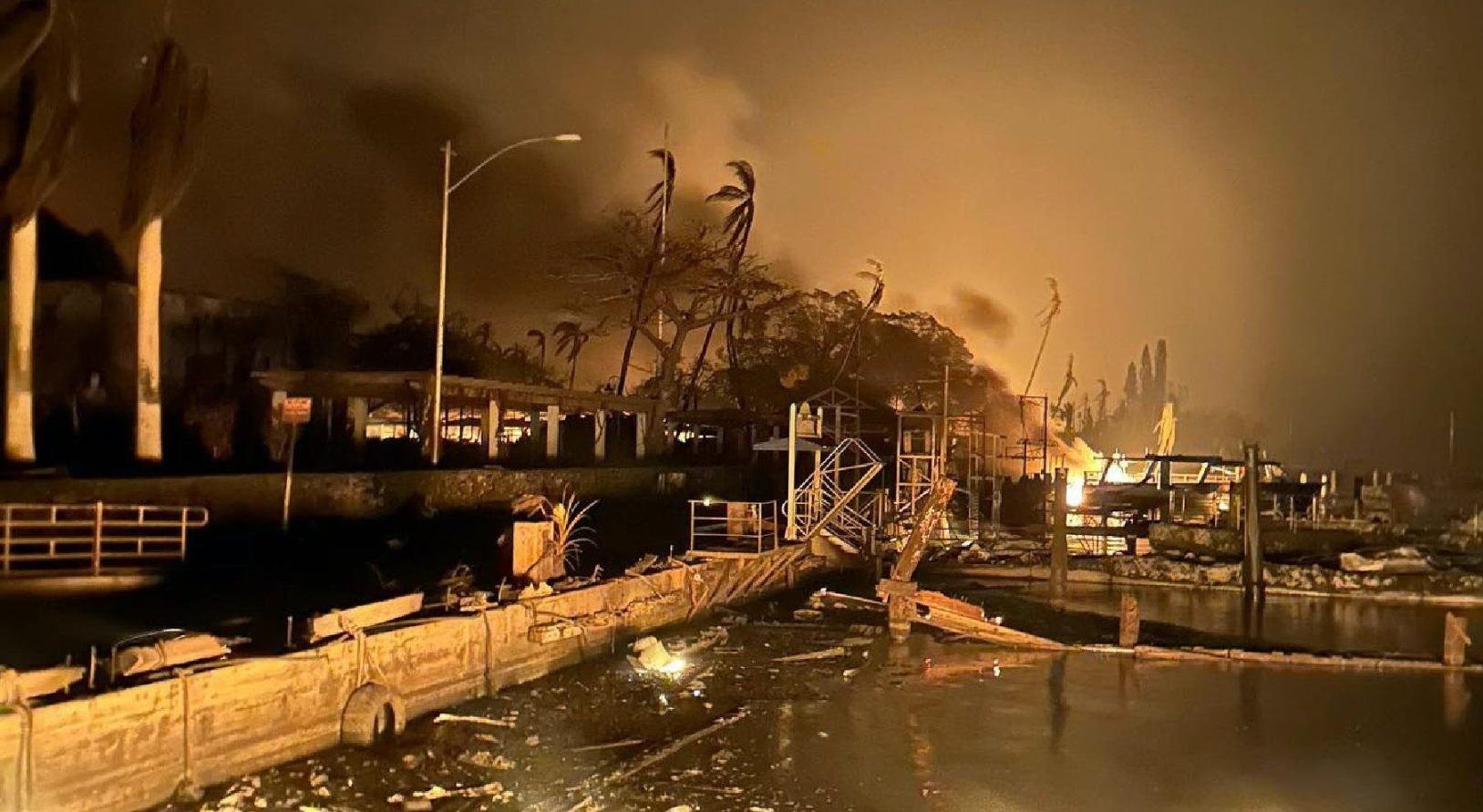The Hawaiian island of Maui has been devastated by wildfires, leaving nearly 100 dead at the time of writing. The inferno has been described as the deadliest natural disaster in the history of the state of Hawaii. But in fact, there was little natural about this tragedy. It was an accident waiting to happen, facilitated by the capitalism-created climate crisis, and disproportionately affecting poorer neighborhoods on an island treated as a luxurious plaything by the wealthy.
In particular, the town of Lahaina—home to more than 13,000 people—has been virtually wiped out, with most of its buildings burned to the ground. Authorities expect the death toll to climb much higher as search and recovery efforts continue. Another 1,000 people are considered missing, their fates not yet known. Hundreds are doubtlessly buried under the smoldering rubble.
Although Lahaina was equipped with regularly tested emergency sirens put in place after tsunamis smashed the island in 1960, many survivors reported receiving no warning of the impending danger. This left them only minutes to flee with no more than a carload of their loved ones and belongings. Witnesses described lines of fleeing cars overtaken by the flames, with charred bodies still lying in them unrecovered.
 The inferno has been described as a natural disaster, but there was little natural about this tragedy / Image: US Civil Air Patrol, Wikimedia Commons
The inferno has been described as a natural disaster, but there was little natural about this tragedy / Image: US Civil Air Patrol, Wikimedia Commons
Many survivors received second-degree burns, barely escaping as flames engulfed their homes behind them. One resident related the desperate scene: “People are jumping in the ocean to escape the flames, being rescued by the Coast Guard. All boat owners are being asked to rescue people. It’s apocalyptic.”
Around 1,400 people are being housed in emergency shelters, their homes and possessions charred to cinders, advised to drink only bottled water to avoid dangerous contaminants, and to limit calls and texts to worried loved ones so as not to use up limited bandwidth.
While Lahaina is known as a “prosperous” tourist area, all of its profit-making services and activity was driven by a local population of workers who staffed its docks, resorts, restaurants, and hotels. Unlike the wealthy vacationers and golf-playing retirees they serve, these ordinary Hawaiians do not live in the lap of luxury. Indeed, Lahaina’s overall poverty rate is substantially higher than the Hawaiian average.
The vast majority now find themselves both homeless and jobless on an island where the cost of living is far out of proportion to the services and resources available. This one-two punch comes after barely recovering from the hardships of 2020, when COVID-19 brought Lahaina’s economy grinding to a halt and unemployment reached over 27%.
As tourism across Hawaii revived after the pandemic, housing costs exploded by 35% as landlords renting to tourists and property speculators took the lion’s share of housing and blocked the construction of cheaper rentals. With no prospects remaining on the island, refugees have been cramming into Maui’s airports in hopes of finding seats for their families, their situation growing more bleak and stressful day by day.
With hundreds of homes and businesses gone and thousands of people displaced, the trauma and loss in Lahaina tells a tale that is becoming all too familiar, especially across the US where more than four out of ten people have been personally impacted by a climate disaster. By all accounts, the cumulative factors driven by climate change over the last few decades, which have produced some of the worst natural disasters ever recorded, were also responsible for this latest calamity.
For one thing, Maui is facing a severe drought. On top of this, the island is covered in non-native species of grasses, introduced by cattle ranchers in the 19th century, which dried into highly-combustible kindling in the hot and dry conditions. In this sense, the legacy of US imperialism and colonialism played a key role in the disaster.
In subsequent decades, vast swathes of nonnative grasslands left unmanaged by large landowners (particularly after the 1990s) saw large-scale monocropping, which in turn “led to the rapid loss and degradation of native ecosystems through increasing dominance by non-native plants,” according to a 2021 study in the journal Perspectives in Plant Ecology, Evolution, and Systematics. The same report concludes these plants have contributed to the frequency and strength of fires.
But a third factor of climate-change-driven extreme weather added to the perfect storm. Hurricane Dora, passing 400 miles south of Hawaii, was initially expected to only minimally affect the islands. So it was, until rapid storm intensification—a typical effect of climate change—caused it to grow from a tropical storm to a Category 4 hurricane in less than 72 hours, gaining strength over the warmer-than-ever water of the Pacific. In the drought conditions, Dora’s peripheral yet strong downslope winds spread the fire at a hellish rate as it descended on Lahaina.
 The trauma and loss in Lahaina tells a tale that is becoming all too familiar / Image: US Civil Air Patrol, Wikimedia Commons
The trauma and loss in Lahaina tells a tale that is becoming all too familiar / Image: US Civil Air Patrol, Wikimedia Commons
Given the increased risks, the state administration was woefully underprepared. Indeed, a preparatory emergency management plan commissioned by the state of Hawaii last year concluded that the risk of wildfires to the population was “low.” None of the emergency sirens dotted across the island to give warning of tsunamis and earthquakes activated, and the lack of firefighting resources was so dire that charities and NGOs assumed responsibility for much of the initial response.
People are already expressing anger at the inadequacy of the government’s action. Local Lorrie Nielson, quoted in the Washington Post, detailed the scope of destruction, with homes, business, schools and other essential utilities reduced to embers. “Do you think the government is here right now helping us?” Nielson said. “Guess who’s feeding us? The community.”
A network of local people have stepped in to bring convoys of donated goods by boat, captained by ordinary people, including boxes of diapers, first aid kits and canned food. These civilian vessels have made dozens of trips and delivered thousands of pounds of supplies, showing the ingenuity and resilience of working people in the face of an emergency, despite the shortcomings of their elected leadership.
Contrary to what is posed matter of factly by liberal commentators, it is insufficient to explain the phenomenon of climate change as “human driven.” Rather, we must understand that it is class driven. It is enough to note that, despite the “lifestyle choices” and “habits of consumption” of billions of people on this planet, just 100 companies have been responsible for 70% of global greenhouse gas emissions over the past 35 years.
As the world experiences the hottest summer ever recorded, and as Europe is in flames from similarly unprecedented wildfires, Maui’s climate refugees now join the more than 110 million people who are internally displaced in the world today due to conflict, disasters, and economic crisis—a grim record and condemnation of the global capitalist system’s inability to provide for human need.
Meanwhile, investment in fossil fuels is expected to hit a record high of over one trillion dollars this year—the very opposite of the cuts in use and emissions required to avoid the worst effects of climate change.
For communists, the question of climate change is always a question of class struggle—of overthrowing the system that pollutes and exploits our environment while disregarding social needs. From the too-late alerts sent out across Lahaina to prevent loss of life, to the lack of immediate relief and services provided for refugees whose labor sustained Lahaina, from the mismanagement of Hawaii’s resources by fatcat landowners and agribusiness, these disasters are a constant and inevitable reminder that in order to adapt to the demands of climate change and ameliorate its effects, we need a socialist revolution in our lifetime.
 It is insufficient to explain the phenomenon of climate change as “human driven.” Rather, we must understand that it is class driven / Image: US Civil Air Patrol, Wikimedia Commons
It is insufficient to explain the phenomenon of climate change as “human driven.” Rather, we must understand that it is class driven / Image: US Civil Air Patrol, Wikimedia Commons
To confront and survive climate change, we need massive investment in infrastructure, as well as paid and voluntary relocation, retraining, and rebuilding out of wildfire zones and other disaster-prone hotspots. Disaster response and relief should not be left up to chance and open to critical failures, but must become part of a well-maintained and fully funded system for disaster and loss prevention. Further, a plan to redirect resources from fossil fuel production into reliable, sustainable energy is needed, as part of a rationally planned economy.
But this would only be possible on the basis of a workers’ government fighting to implement a socialist program. The expropriation of the banks and corporations responsible for the criminal mismanagement of our natural resources and economy would yield all the resources necessary for this transition, while democratic workers’ control over these means will ensure that human lives and needs are the priority, not the profits of multinationals, speculators, and landlords.
The horrors of capitalism are not the be-all-end-all for our species. A better world is possible, and desperately needed.
Join the communists, and fight for a global system where, for the first time, humanity isn’t held in thrall by a tiny minority that suicidally advances its own interests at the peril of civilization.

